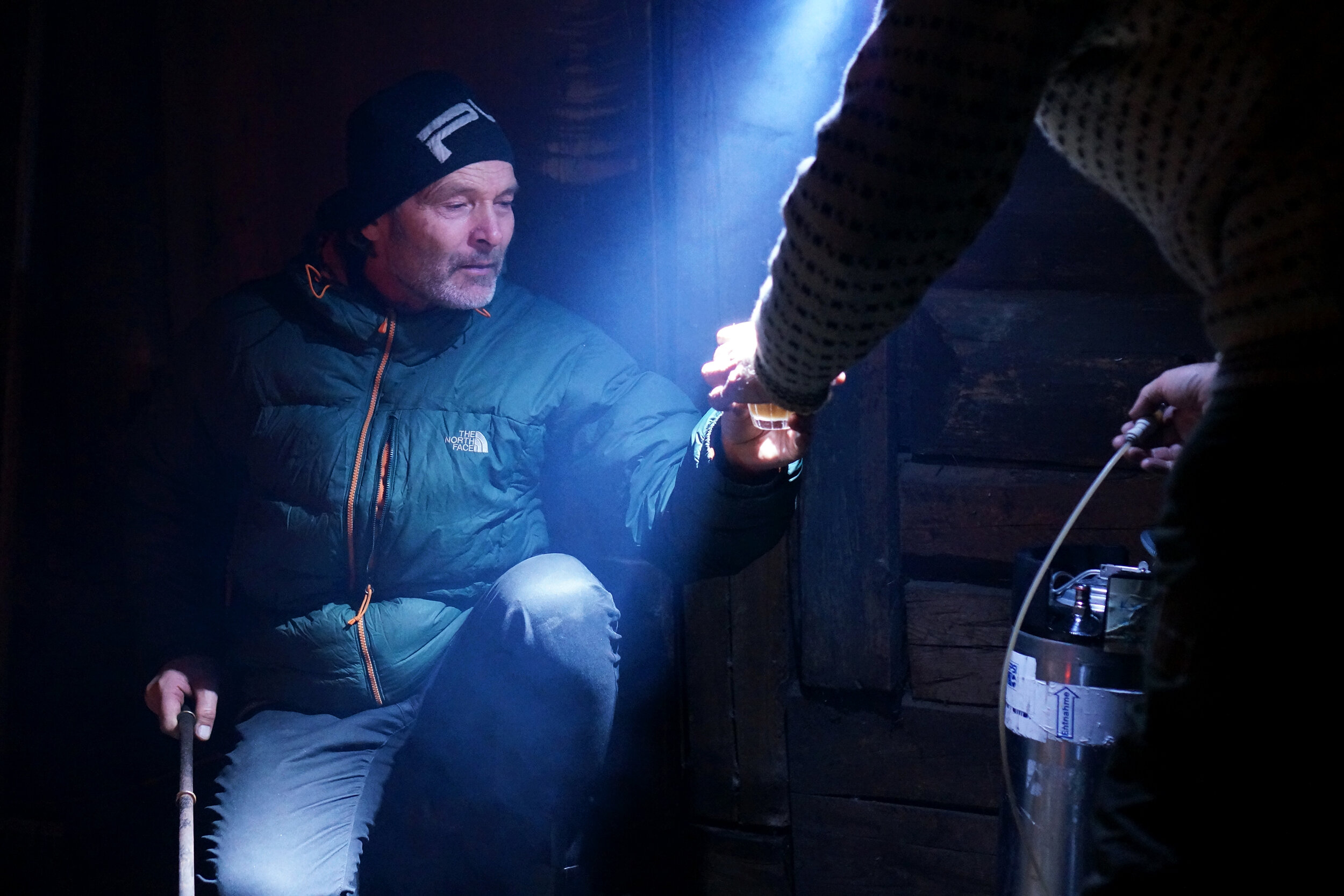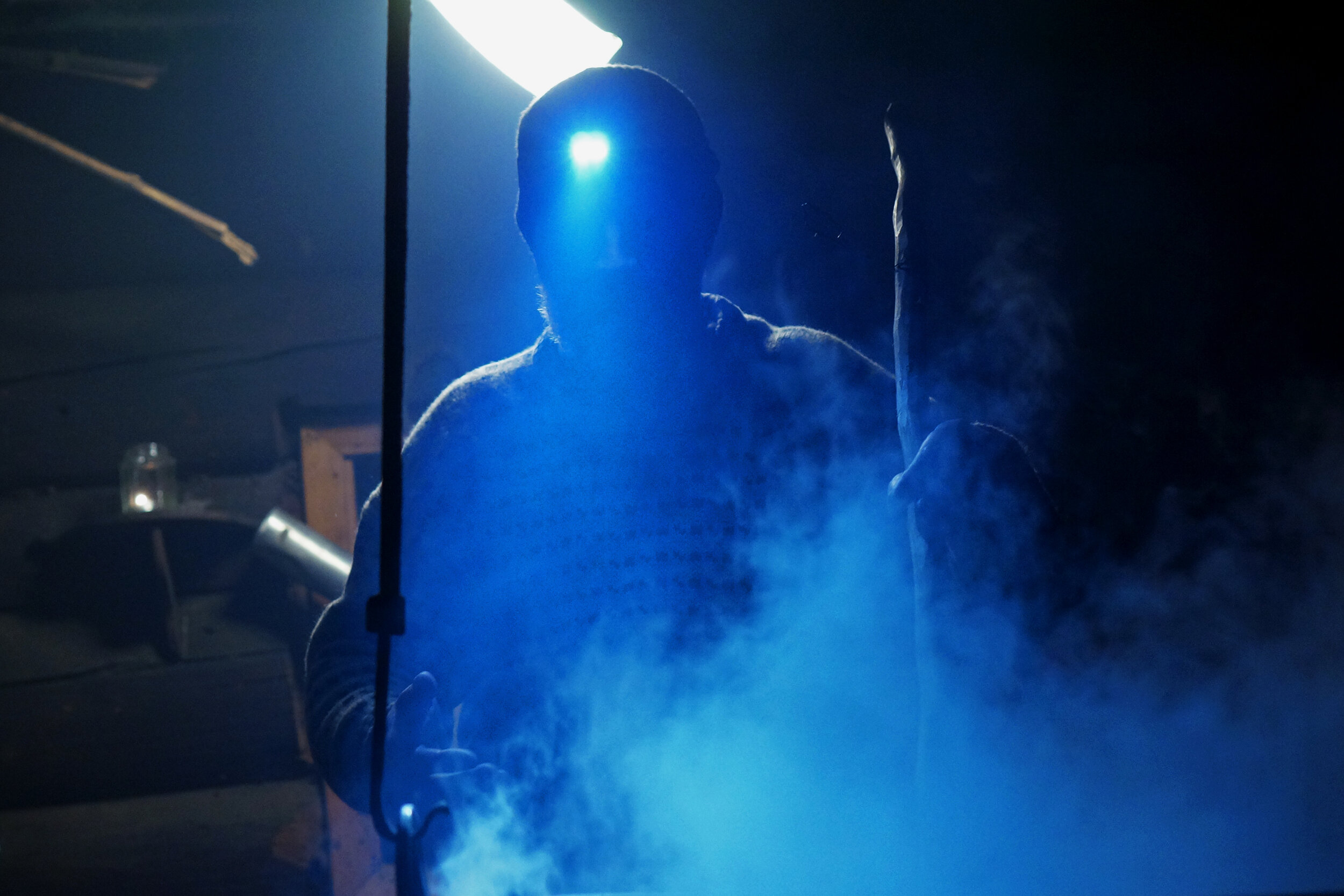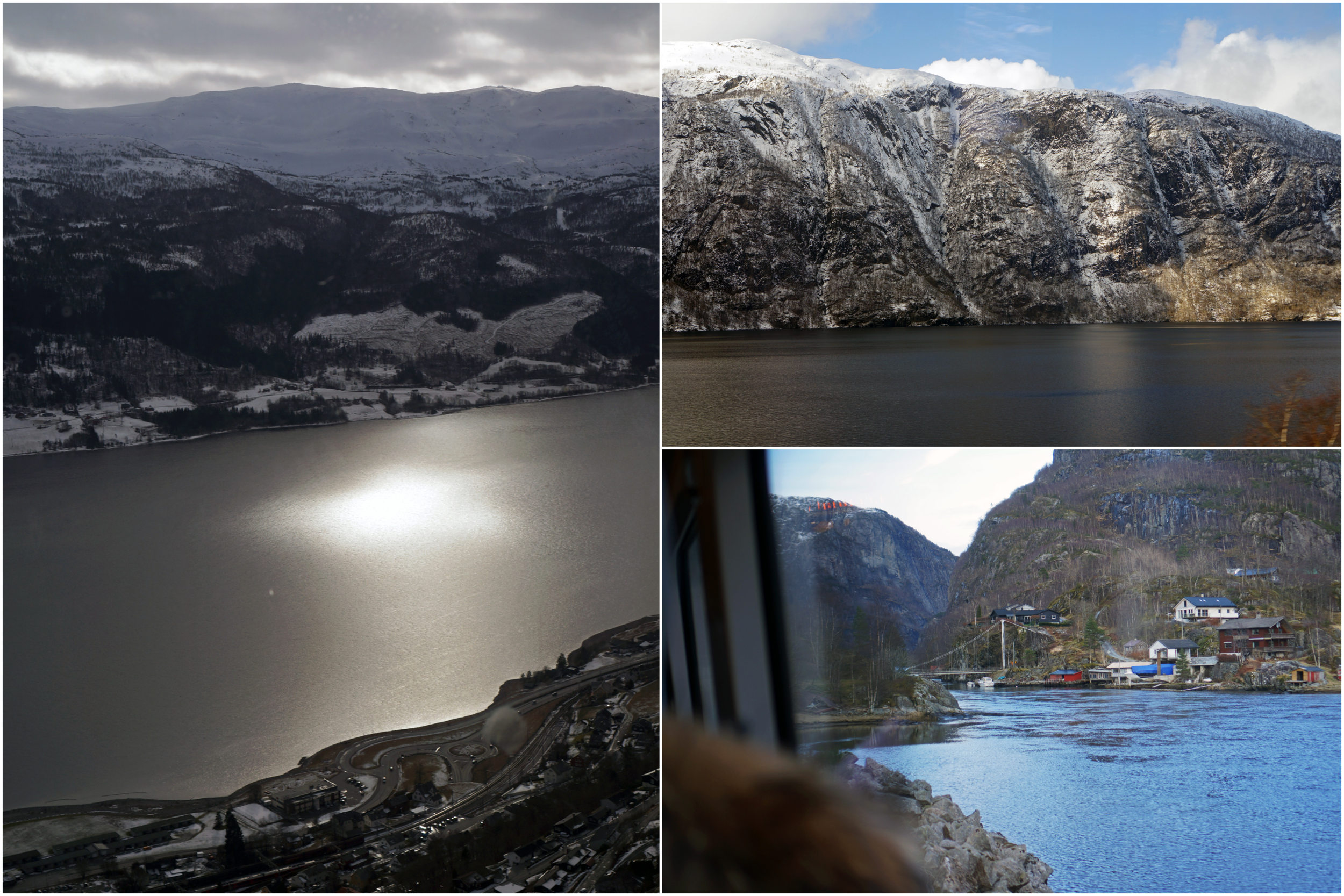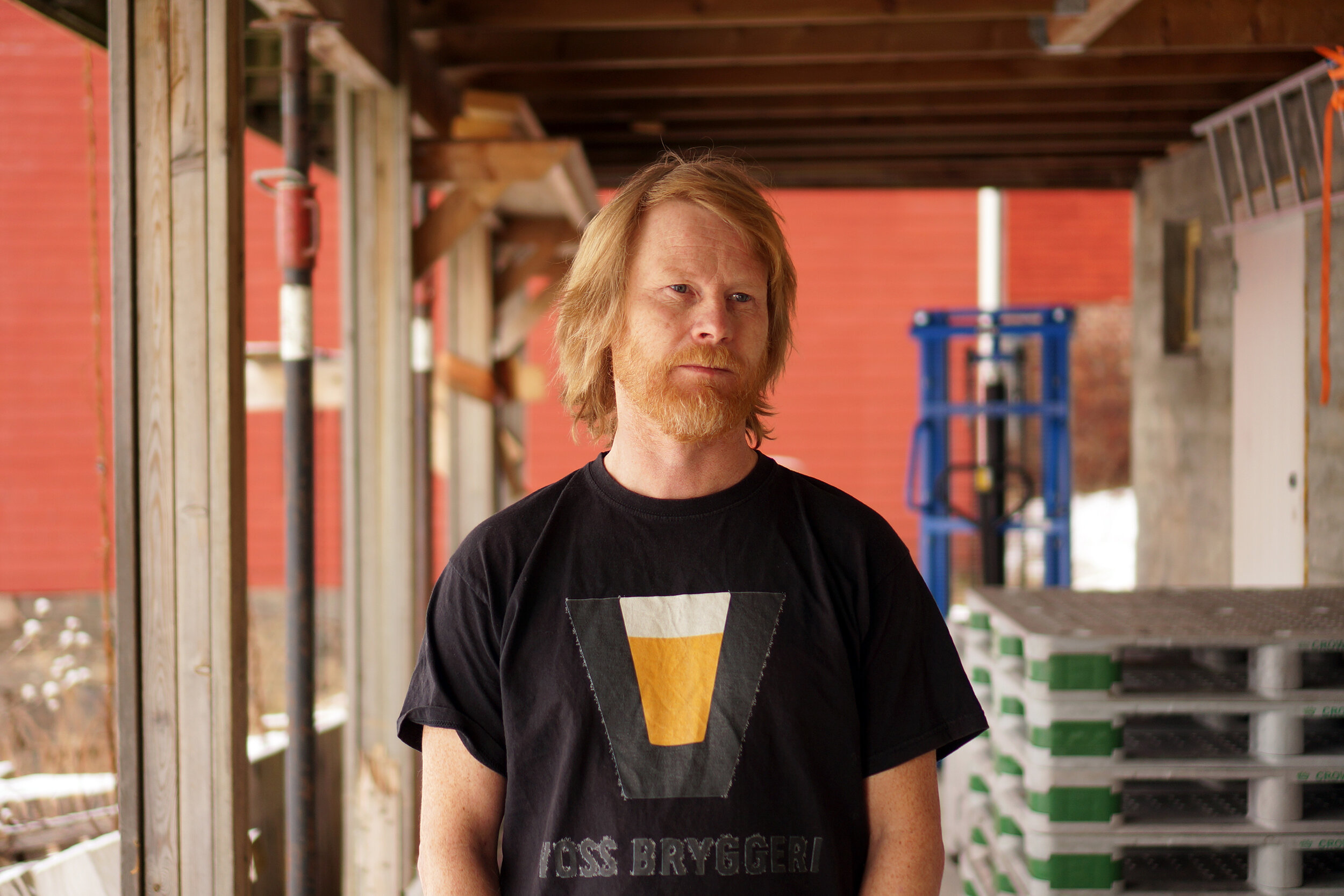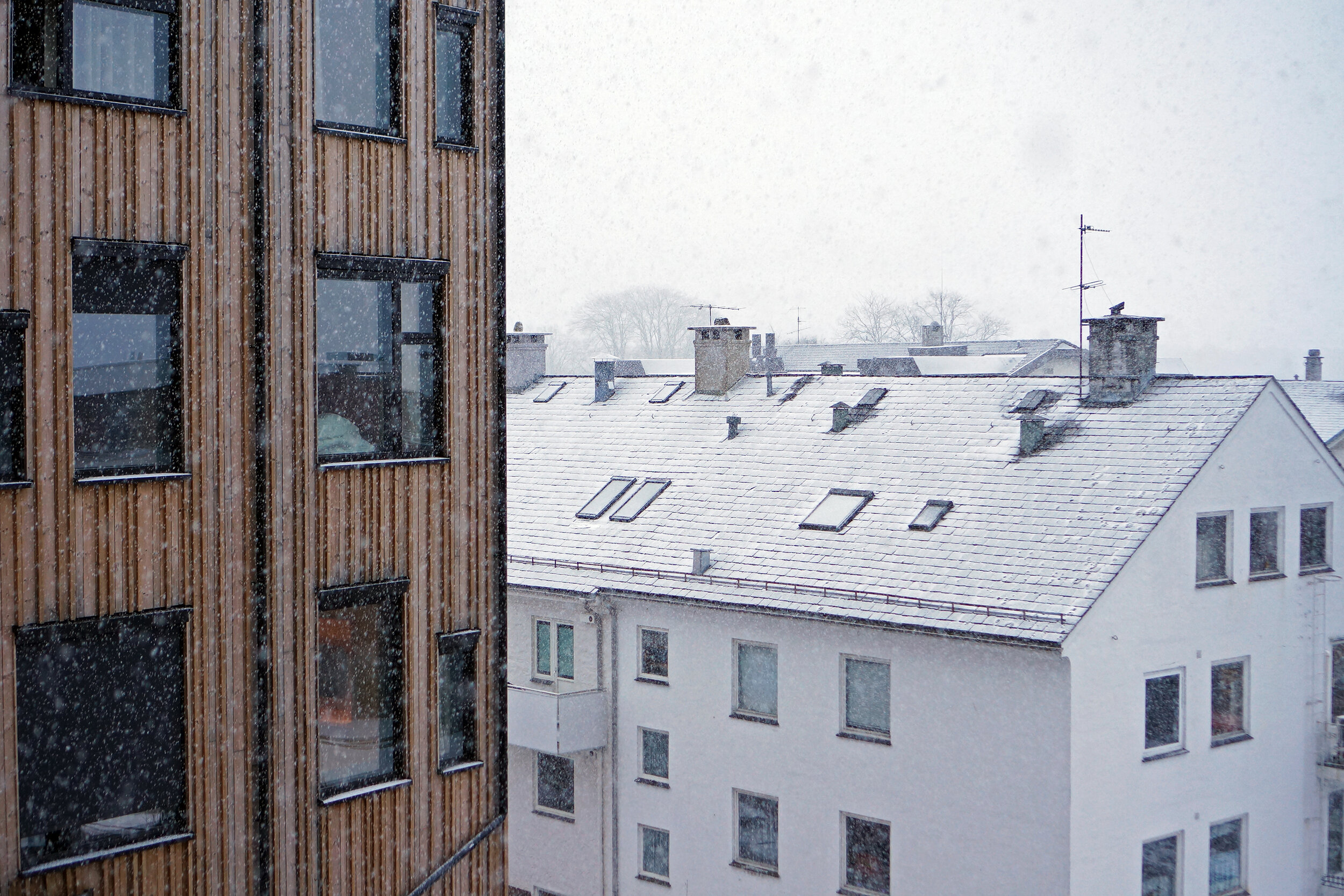The smoke announced itself before we did.
A group of us paused on the hilly outskirts of Voss, Western Norway. It was February, so by early evening the sky was ink and the highway below a line of gold against the snow. We were on Jon Gjerde’s land, and to reach his timber smokehouse, we had to slip our feet into the hollows where other people’s boots had broken through the frost.
Inside, the smokehouse was spare, blackened. In its center was an immense cauldron, fed by flames, holding 150 liters of juniper infusion. Smoke swirled at chest height like its own weather system. Standing up meant stinging eyes and straining lungs, so we sat on the benches lining the walls; still the smoke permeated every strand of hair and stitch of clothing. It was warmer inside than out, but not warm enough to take off our coats.
While Gjerde blew into the flames and carved the lamb leg that he had smoked in the building’s rafters, fellow brewer Arne Vidar Brekke served me my first-ever glass of Vossaøl: the kveik-fermented, farmhouse beer style that hails from Voss. Against the firelight, it was the same amber as petrified tree sap. I thought of boreal forests when I drank it, its notes of resinous juniper in contrast to its concentrated, caramelized malt base. In the background was that local kveik character I had waited so long to taste for myself. Orange. Baking spices. Christmas in the darkness, two months late.
I had flown from London to Bergen, and taken a train from Bergen inland to Voss, for this glass of beer, for this spectacle. Seven months after writing my first story about kveik—Western Norway’s lightning-quick, hot-fermenting farmhouse yeast family, recently rediscovered by mainstream beer, and now a phenomenon around the globe—I had finally arrived at its cradle. I had come to meet the farmers who were still making beer according to centuries, if not millennia, of tradition. Our disparate group of journalists, local brewers, visiting yeast scientists, and representatives from the Western Norway Cultural Academy all piled into Gjerde’s smokehouse for the occasion.
We were lucky: for most, traveling to its source is still not enough to find kveik. The average tourist might expect an infrastructure of tastings and demonstrations, specialized beer bars and taprooms, but there is virtually no formal network ready to meet the growing demand for these traditional beers. Brewing of this kind happens mainly on family homesteads, rarely ever on professional premises. If you are not already acquainted with the brewers—most located beyond the cities, some deep into the wilds—you are not likely to meet them by chance.
Granted, this wasn’t quite the real experience. Making Vossaøl requires nearly a full day of labor, hours dedicated to reducing the wort alone, and so this was merely a demonstration of the first stage, when a juniper infusion is prepared as a base for the mash, and for use as a disinfectant. As we watched the cauldron boil, Brekke pulled some recently harvested juniper out of a repurposed malt bag and passed around the prickly boughs.
More than a brew day, this first meeting was a facsimile of oppskåke: the grand tradition of neighbors coming together to drink a fresh batch of beer and shoot the shit. Even as I shivered, I watched the Norwegians move cheerily around the room, pouring beer and inspecting plastic fermenting vessels, some wearing nothing warmer than leather jackets and sweaters. They seemed impervious to the conditions, trained by a lifetime out among the elements.
Anyone can get used to anything. To the Cairenes, the sight of the Great Pyramids must be as unremarkable as skyscrapers to New Yorkers. If you have seen the Eiffel Tower outside of your dormer window every day of your life, it will feel as natural as the seasons. There is not a part of this world that remains a constant wellspring of awe—proximity will always wear down the extraordinary until it assumes mundanity.
And so, on the train from Bergen to Voss, most passengers kept their noses in laptops or books while I scrabbled with my camera, failing to capture every staggering scrap of landscape that shot past. Too late: those scarred mountains had vanished. A single, perfect red cabin against the snow, smeared by speed. A narrow waterfall, not yet frozen. Sky-reflecting fjords, gone in a flash. My seatmate raised an eyebrow in irritation at every report of my shutter.
Voss is home to some 15,000 people, just 42 miles inland from Bergen (Norway’s second-largest city) as the crow flies. It occupies a narrow valley ringed by mountains. Despite the relative proximity to the coast, the enormity of the land’s scale—its rippled peaks and deep plunges—makes Voss feel like a remote settlement, far from urbanity.
It once was that way. “Before the roadway for cars, [Voss] was more or less isolated during the winter. Totally. You had to ski or have a sled. But the point is people had to make sure they had everything they needed for centuries and centuries and millennia probably,” Brekke said. “The other villages, you could go on a ship and be in Europe or the British Islands, but Voss had an infrastructure challenge during the winter. So they had to cure the meat, and the smoking is because you don’t always have the cold, dry climate. So you have a lot of traditions that were necessary to keep people living here.”
The city’s impenetrability began to disappear with modernity, and many of its old traditions—farmhouse brewing among them—have been in broad decline since the 19th century. Now, the warming climate poses the latest existential threat to the area. Even as I woke to heavy snowfall and had to bundle against the vivid cold each morning, the locals looked up to the mountains and remarked how late the winter had arrived this year, how much longer it took for the snow to bed in. Every autumn, waters flood into the valley, higher all the time, and whole farms have started slipping away into the region’s fjords after periods of heavy rain.
“In most of the places in Europe where farmhouse ale is brewed today, the tradition seems likely to go extinct within one or two generations. [...] Voss in Norway has perhaps 50 active brewers, so brewing there may be safe for another generation or two.”
Today, to the average Norwegian, Voss is known primarily as a capital of winter and extreme sports. During my visit, a cable car ferried a constant stream of pink-cheeked families and their skis up to the Voss Resort in the morning and down again in the evening.
“There is no other place in the world where you’ll find so many gold or silver medals from Olympic winter games in the same community,” said Atle Ove Martinussen, CEO of the Western Norway Cultural Academy. “Jon”—he gestured at Gjerde—“is a hang gliding champion of the world.”
“I was out flying yesterday,” Gjerde said with a shrug.
“We say the secret is the beer,” said Martinussen, only half joking.
As the night deepened, we traveled across town to Kjetil Dale’s farmstead, where a batch of Vossaøl was underway. His smokehouse was slightly bigger and brighter than Gjerde’s, but just as frigid; even more smoke garlanded the rafters.
There in the cold, our talk rose and faded like steam as we drank a previous batch of Vossaøl and watched the fire, our boots propped near the flames for warmth. With every temperature drop, with every further glass of beer, the hearth became more mesmeric, the room’s primary source of light and heat. I understood then why the pre-Christian Norwegians believed there was a god in it, how it could feel like the origin of all life.
When it was time to remove the cauldron from the fire, Dale rose to the tips of his toes and heaved his body weight against the beams the cauldron hung from, careful not to spill the boiling wort. Once it had cooled to a mere 102° Fahrenheit (39° Celsius), he produced a dented aluminum can and poured in his family’s kveik. Thus inoculated, the wort was transferred to plastic tubs, which were strapped to a snowmobile and ferried across the pocked ice to a separate building on the farm. The Vossaøl would be ready to drink in two days’ time.
It’s true that kveik behaves in remarkable ways; that it comes from a place of great beauty. The discovery that farmhouse brewing is still alive, that its ancient traditions have escaped extinction, is one of the most important things to happen to beer in a generation. But in thrall to the fairytale, I’d also overlooked the sweat, the choking smoke, the particular darkness of smokehouses, the way that the cold burrows into the skin and turns into pain where it reaches marrow. The reality of physical labor—what it does to brewers’ bodies, the danger inherent in industry—is almost never the main story, in any part of the beer world, though it is what brings beer into being.
Ultimately, romance ends where hard graft begins. The particular image I had had was one seen through a vaseline-smeared lens: cozy fires and thick woolen sweaters, snowdrifts and juniper-foraging missions. Hygge by way of Norway, in other words; Scandinavian cottagecore. Until my visit, I hadn’t understood that farmhouse brewing was quintessentially about survival, a fight for life in a place that is harsh and inhospitable for large swaths of the year. Its practice is animal and elemental, in the bottom tier of Maslow's hierarchy of needs. It has little to do with my citydweller’s fantasies of Subarctic pastoralia.
“The people on the farms lived by what they could make, so farmhouse brewing was shaped by the prevailing economic conditions,” writes Lars Marius Garshol, the man almost singlehandedly responsible for kveik’s revival, in his new book, Historical Brewing Techniques: The Lost Art of Farmhouse Brewing. “People back then were poor in a way that is hard to understand today, so even the most basic things might have been out of reach. If the farmers could not grow grain they could not brew beer. If there was not enough barley, the malt would have to be augmented with other grains.”
The smokehouses I visited were humble, without frills, and if they had a primordial feeling about them, that’s because their design and function have changed little since the Neolithic age. “Dwelling houses with an open fireplace represent a common European tradition that’s not a specific tradition in this region, but it’s all over Europe, and in particular around the North Sea,” said Professor Ole Didrik Lærum, who spoke at a symposium on kveik and farmhouse brewing held in Voss during our visit. The smokehouse was where most families’ living happened, for thousands of years. The hearth was a gathering place, where meals and stories were exchanged, where families sometimes slept, and where the promise of warmth resided.
None of this is as far-off as it sounds. Such dwellings were still used into the 19th century. A well-preserved example of a traditional farmstead lives in the heart of Voss: the Voss Folkemuseum, which is situated in the Mølstertunet cluster, a group of farm buildings whose roots predate the Viking age. As we walked around the scattered outposts, our guide pointed out the dirt floors, the brewing tools, the ladles, the small hole in the smokehouse ceiling which let out the smoke and let in a wan shaft of light.
I tried to picture the families living there in near-darkness for half of the year. I began to understand how fire and smoke were once as fundamental as oxygen.
If brewing was, until recently, a ubiquitous practice at the region’s farms, it has all but disappeared since industrialization and capitalism made self-sufficiency an anachronism. Today, it is now the province of a few holdouts. As Garshol put it, the tradition already has one foot in the grave.
“In most of the places in Europe where farmhouse ale is brewed today, the tradition seems likely to go extinct within one or two generations. [...] Voss in Norway has perhaps 50 active brewers, so brewing there may be safe for another generation or two,” writes Garshol in Historical Brewing Techniques. “In many places, however, brewing is down to just a couple of families still stubbornly holding out. [...] But two families is not much. One brewhouse that burns down, one child that does not like the old-fashioned beer is all it takes, and several thousands of years of tradition will be dead. And once it dies, it is lost forever.”
The urgency of the need to protect Norway’s brewing heritage is tangible, but even for those who are motivated to do so, the barriers are formidable. There is the fact that farmhouse brewing resists replication: in kveik’s case, each farm’s culture is idiosyncratic down to its DNA. The traditions passed on by brewing families are variable, and at times contradictory. Most brewers don’t measure the gravity of their wort or take temperatures when pitching yeast. Recipes for beer styles are virtually nonexistent, and even if they were written down, they would vary enormously.
Still, despite those challenges, some commercial breweries are beginning to experiment with farmhouse styles. Voss Bryggeri was founded in 2012 by Jon Gjerde, as well as the formerly Oslo-based homebrewer Dag Jørgensen and his partner, the craft beer bartender Jeanette Lillås. The brewery is housed in a sun-yellow building on the edge of town, formerly a creaky general store that served the small community of slate miners who lived overlooking the valley. The mountain views from its patio have the uncanny perfection of a screensaver.
Though Voss Bryggeri initially made its name with IPAs and modern, hop-driven styles—its first brewmaster was formerly of Bend, Oregon’s Boneyard Brewery—the brewery and its city-center brewpub, Tre Brør, are now the most reliable places for tourists to find kveik-fermented beers in Voss. Since 2014, Voss Bryggeri has produced a Vossaøl, which has the distinction of being the first commercial version of the farmhouse style in the country.
“Vossaøl is made with a lot of pain and fear. Getting acceptance from the brewers around us—because they all make the best beer in the world, in their mind,” Jørgensen said as we toured the brewhouse.
“Vossaøl is made with a lot of pain and fear. Getting acceptance from the brewers around us—because they all make the best beer in the world, in their mind.”
They were careful to do their historical research, Jørgensen noted, and held tasting panels with local farmhouse brewers throughout the beer’s development. With the farmers’ input, the brewery worked through multiple test batches and slowly tweaked the recipe. “It took us a while. We did a big project on it. It was actually a researcher that put us in an article later, and used us as an example of a good way of reproducing historic beers,” Jørgensen said. “So we got a lot of credit for doing it that way, and the brewers, the farmers of Voss stood behind it in the end. It was good. We're there, we did it. This is the one.”
Today, Voss Bryggeri’s Vossaøl is imported to the U.S. in limited quantities by B. United. It is also shipped to the U.K., and is found in some 300 outlets of the Vinmonopolet, Norway’s state-owned and -operated alcohol monopoly.
Still, Jørgensen confessed, it isn’t a best-seller—not even in its home country. “So the market for Vossaøl is not the best. [...] It’s hard to manage the heritage of kveik beers because the market isn’t great for them, unfortunately.”
Within Norway, there persists a surprising gulf of knowledge about farmhouse brewing traditions. “Unless you come from Voss or you've spent a considerable amount of time there, you will never have tried Vossaøl, and most likely you will never have heard of it,” Garshol told me in a follow-up conversation. “Farmhouse ale is just this completely separate category where almost all of the beers have been completely unavailable. So, the whole genre has been out of reach for almost everybody.”
The obscurity of farmhouse brewing and its myriad technical challenges make attempts at revival difficult. A complicating factor is that, for many Norwegians, it is an anachronistic reminder of the times before oil was discovered, before Norway became fantastically wealthy. It is, in the view of many, the deeply unfashionable province of old men doddering in the wilderness.
“[T]his form of brewing was regarded as old-fashioned, strange, and connected with the shameful poverty of the old days,” writes Garshol in his book. “Several brewers have told me how their own family members refused to teach them brewing, seemingly embarrassed by it. In many places, the people brewing today learned their craft from their grandparents, because their parents did not bother to learn farmhouse brewing, having never appreciated the tradition.”
Young and upstart Norwegian brewers who might balk at the hard labor, time, and space required to make beer the traditional way are also more likely to be interested in international beer trends. “Norwegian brewers are so busy listening to what's happening in America, that if you try to talk to them about traditional brewing, they go, ‘Shut up. I'm listening to the Americans,’ Garshol said during his talk at the Voss symposium. “So we have to make the Americans tell Norwegians about this.”
These factors might be why Norway has been slow to wake up to its own natural wealth. Obscure, fusty, and inaccessible as it might seem domestically, Norway’s farmhouse brewing is an extraordinary asset, a precious time capsule, the beer-world equivalent of the Rosetta stone. With farmhouse brewing, the country lays special claim to an ancient lineage. It is one of the few places on Earth where those traditions have carried on in an unbroken line into the 21st century, and can still be experienced first-hand. Vossaøl and its fellow hyper-local styles should be as important in the pantheon of European beer as German Lager or Belgian Lambic. But a tremendous PR push will be needed to make the general public believe that.
In February, a small cohort of historians, scientists, and local officials announced their intention to submit Norwegian farmhouse brewing with kveik to UNESCO’s Intangible Cultural Heritage List. If it is accepted, it will join the likes of Jamaican reggae music, Neapolitan pizza-making, and yoga in India, though the application will take at least two years to compile.
“My hypothesis is that kveik goes back to when agriculture started in the Western part of Norway, at least 4,000 years ago.”
“My hypothesis is that kveik goes back to when agriculture started in the Western part of Norway, at least 4,000 years ago,” said the Western Norway Cultural Academy’s Martinussen, who is overseeing the application process. “We have archeological findings at least 2,000 years before Christ that actually show that beer has been produced. [...] Beer has been a very strong part of agricultural life, rituals, festivals, and in Norway with the burials [and] when you have a birth of a child.”
His goal, Martinussen said, is to establish a “molecular time clock of kveik.” In partnership with entities like the Norwegian Institute of Bioeconomy Research (NIBIO), his team will examine archaeological findings for centuries-old yeast cells, and will gather information about those who are still practicing local brewing traditions. Separately, the Western Norway Cultural Academy is building its own yeast lab to hold kveik cultures, and is constructing a brewhouse facility at its headquarters where farmhouse brewers will be able to hold demonstrations and classes, and more readily pass on their skills to new generations of brewers.
A successful place on the UNESCO Intangible Cultural Heritage List would be enough to boost Norwegian brewing’s international credibility, and perhaps to earn it increased awareness and admiration from the Norwegian public. But it is only just the start of what’s needed.
Garshol has a marketer’s mind, and a kinetic energy underlies his campaigning. He is visibly frustrated by the slowness of his countrymen, of Norway’s tourist boards, to catch on to what they have; he has been busy finding new ways to spread the word. The reason he published his most recent book in English is because he thought of the project primarily as a marketing exercise, he admitted. He’d like to see a TV series on farmhouse brewing produced for Norwegian audiences, he told me, and a network of experiences made available to beer tourists: recreated oppskåkes, beer dinners in brewhouses, traditional music to round out the experience.
“I think there's even a market for, let's call them, normal people,” Garshol noted during his symposium talk. “The cruise ships that are out here in Western Norway, by the dozens, every summer. Tens of thousands of people flood out of these cruise ships, and then we sell them fleece jackets and we take them to see the glaciers. And the glaciers are going away. These people, in many cases, walk past traditional brewhouses. Could you interest them in going inside? You see the wood fire, the copper kettle, the juniper in it. This is massively Instagrammable. That's the sort of stuff that people go, ‘Oh, let me put this on Facebook immediately.’ Then you have the kveik, you serve them beer in a wooden bowl with horse head handles. They're going to talk about it for years.”
Even as Norway slowly begins to promote its brewing traditions to the wider world, it is also grappling with new feelings of protectionism. Kveik has taken off around the globe in a way that other elements of farmhouse brewing have not, and so it is a natural place to ground most publicity efforts. But kveik has also become a flashpoint of controversy, as its use has become increasingly divorced from its origins.
“I think this issue of many of the breweries and the yeast labs not wanting to acknowledge the original owner, or the source of the kveik—that's probably going to be increasingly frowned upon in the future,” Garshol said during his talk. “At least, I hope so. I'm going to frown on them.”
Unfortunately, frowning might be the strongest weapon in the country’s arsenal. There are few ways to safeguard kveik, particularly now that it is already everywhere; you might as well try to delete something off the internet. While the Nagoya Protocol, ratified in 2010, dictates the way that genetic materials can be shared internationally—and aims for “the fair and equitable sharing of benefits arising out of the utilization of genetic resources”—it does not provide robust protection for the owners of individual yeast cultures. Some farmhouse brewers have opted to license their yeasts to specific labs as a workaround, but even that is hardly bulletproof.
“Aldona Udriene of Jovaru Alus in Lithuania [...] licensed her yeast to Omega Labs for sale. So, they are actually paying her a percentage. And then at least one other lab, they just bought the packet of Omega Yeast and started propagating and selling it,” Garshol told me. “And I told them, ‘Guys, if you're going to sell this you should be paying something to Aldona.’ Although, of course, legally there's nothing to enforce that.”
That said, most of the brewers Garshol has spoken with don’t seem too bothered about the money, he told me. They’re fiercely proud, delighted that their kveik is coveted by brewers from all over the world; anyway, it’s not like there’s big money in yeast labs. The issue, instead, is in the way that their kveik has been degraded and atomized as it has spread.
“Now we have rediscovered the kveik and then some companies [...] start taking out a yeast type and isolating it and basically taking the kveik apart. So what we're trying to do is preserve the kveik culture as it is, the asset it has been for centuries,” said Arne Bøhmer, CTO of the Kveik Yeastery, during a recent conference call.
The Kveik Yeastery is a soon-to-launch production facility that is seeking to change the way that kveik is produced and internationally distributed. According to Bøhmer and CEO Øystein Bakken Vold, the company will pursue a profit-sharing model that will benefit the individuals who have shared their yeast cultures. It will also provide documents explaining the origin story, the specifically Norwegian heritage, of each culture that is sold, in the hopes that brewers will properly credit the source of the yeast. Most importantly, it will leave the kveik intact, which is not something international yeast companies have prioritized.
“Now we have rediscovered the kveik and then some companies [...] start taking out a yeast type and isolating it and basically taking the kveik apart. So what we’re trying to do is preserve the kveik culture as it is, the asset it has been for centuries.”
At one point in the call, Bøhmer held up a packet of Lallemand’s Voss Kveik Ale Yeast, which is produced from an isolated, single strain taken from brewer Sigmund Gjernes’ kveik. He brought it close to the camera, so I could make out the fine print. “Product of Austria,” it read.
Many brewers might not realize the key distinction in this—that a single kveik strain will not always have the same behaviors and attributes of its parent culture, and that it isn’t necessarily accurate to call that strain by its source’s name. Even if they do, they might find it tricky to convey these complexities to consumers on a single label. I have seen many breweries in the U.K., where I live, sell “Kveik IPAs” that not only fail to name the individual farmer the yeast originated from but don’t even mention which region the kveik has come from—or that it has come from Norway at all.
Kveik is broad and multifarious; each culture is distinct, and from region to region, flavors can range from tropical fruit to citrus to caramel to mushrooms. On its own, the word means little. Then again, I recently came across a beer labeled a “Voss IPA,” as if the average consumer has any way to parse that language, as if even most beer geeks wouldn’t be stumped by the phrase. There was no accompanying text on the label to clarify, so presumably most drinkers shrugged and moved on.
Kveik is now indisputably in the world—“that bird has flown,” as Martinussen put it. But businesses like the Kveik Yeastery hope that, by positioning themselves as specialists with direct ties to the farmers, and by providing educational materials, that they will be able to start reshaping the narrative.
On my last morning in snowy Voss, I started thinking about what it takes to rescue something that is already almost dead. I admit a little cynicism crept in.
From one perspective, kveik is now flourishing after being on the road to extinction because it was extracted from its homeland like a rare mineral, drummed up as an exotic commodity (in part by writers like myself), and then used as a marketing and money-making ploy by brewers and yeast labs and beer businesses around the world—all while the farmers who shepherded it across the ages haven’t received payment or, in many cases, even credit.
Despite attempts to claw ownership back, and to remind those in the industry to be respectful of kveik’s origins and pedigree, Norway will never again have full control over its native yeast, or its narrative. The world will benefit from kveik’s abilities, to be sure—but in many cases, kveik had to be simplified and broken down for that to happen. Meanwhile, fewer people every year are investing in making Vossaøl, or other farmhouse styles. It’s possible that, in another few decades, kveik may be the only element that lives on from Norwegian farmhouse brewing.
Maybe the best shot we have at preserving these dying traditions really is to commercialize them, or package them up as tourist fodder; to sell a charade of farmhouse brewing the way hand-blown glass is sold on Murano or whirling dervish performances are sold in Istanbul. Globalization and capitalism have made it impossible for so many of the world’s traditional practices and crafts to survive, so maybe the only way they can live on is as performed simulacra.
This cynicism stayed with me as I boarded my plane home, one more traveler who had come to Norway in my own search for novelty and extraction. In a follow-up conversation with Garshol, I brought these thoughts to him directly. Is there an a priori moral benefit in preserving traditional practices like farmhouse brewing, I wanted to know? Or should they be left to die naturally, rather than be exploited, in a world that is largely inhospitable to them?
“Looking at this farmhouse culture in general, most of it is stone-dead beyond any hope of recall,” Garshol conceded. So many companion traditions have died, too. “A lot of the really detailed crafts, like making rope out of leather and stuff like that, that's not going to survive. You don't need a leather rope.”
But the reason that traditional music and clothing and beer are still around is because they do still speak to contemporary life, Garshol said. Farmhouse brewing still has vitality in it. “[Traditional beers] give people something that they don't get from buying a canned IPA. There is some value there in having a beer that's part of their own identity and their own rituals of making it, and they get something out of the whole social thing around the brewing and oppskåke.”
And, he reminds me, kveik is only one small element of European farmhouse brewing. There are other Norwegian farmhouse yeasts, like gong and berm, that are only just reemerging. There are styles like Finnish Sahti, and Lithuanian Keptinis. There is the whole cosmos of historical vessels and drinking traditions and brewing techniques and ingredients. There is the juniper, so versatile and complex an ingredient, about which we know so little. In many ways, kveik is only the first emissary from this enormous, rediscovered world of farmhouse brewing.
“This whole world of farmhouse brewing is so gigantic that I keep discovering new things that make me go, ‘Oh, really?’ It just doesn't stop. Discovering new regions for things that are still alive. Discovering things that show up in places where they shouldn't. Discovering things you never heard of before. It goes on and on,” said Garshol. “And that’s something I don’t think people really have a sense of yet.”
For Garshol, farmhouse brewing can’t be reduced down to a grab-bag of curiosities. It has the scale of a parallel universe, or of the lost city of Atlantis, newly dredged up from the deep.
“When I started really getting into the sources, I realized that it was actually very big, and that there's a lot here,” said Garshol. “And I realized that there was a sense of having passed through some kind of looking glass, and you see that, ‘Oh, this world on the other side is actually really really big and I'm alone here.’ So, I think that's great. It's a huge playground, right? So, you want to research some question? Congratulations, you're the first to look at it. Not in every case, but in many cases. And that's just amazing. That's a never-ending source of delight basically.”
Garshol is now working on a new book. He wants it to take after legendary beer writer Michael Jackson’s work, and to catalogue previously unknown and uncodified farmhouse beer styles, to make that world newly accessible to outsiders.
In the best-case scenario, if it works, farmhouse brewing centers like Voss might operate in the way that Belgium does now. Western Norway could be a pilgrimage place for beer geeks. It could offer the opportunity to meet producers and taste distinctive beers in their homeland. It could also be accessible for visitors looking to enjoy the general decadence without getting too deep into the specifics. Even if Belgian styles and techniques are used by brewers all over the world, Garshol points out, there is still only one Belgium, only one Senne Valley. The original will always be distinct and held in esteem.
“People want something that comes from the place that they're interested in or that they go to, and something that has a story behind it and more of a real tradition,” Garshol said. “That really resonates with people.”
[Disclosure: This trip was made possible by the Western Norway Cultural Academy and Visit Norway, and we're thankful for their help in making our coverage more comprehensive.]
 Words + Photos
Words + Photos
Claire Bullen Listen


